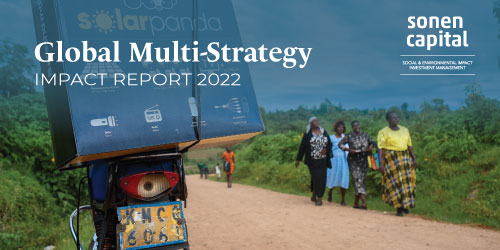Sonen Capital’s Impact Framework webinar, Investing in Financial Inclusion is available for replay. Also included below are responses to additional questions not answered during the webinar.
Q&A Continued….
While the FinTech solutions are lower in cost, it is surprising how little the actual cost has decreased over the period from 2011 to 2018 compared to the decrease in cost with banks, etc. Why is this?
- We believe this is simply a function of increased competition and banks responding to this fee pressure and the necessity to reduce fees to remain competitive.
- There is evidence, also, that pressure from international organizations such as the UN and G20, to lower remittance fees may be generating a response from money transfer companies and banks.
- This article has a survey of the trends among banks, money transfer companies and new FinTech-based remittance services.
What is the role of crypto currencies for financial inclusion? - The underlying technology of cryptocurrencies, Blockchain, appears to carry immense potential in expanding financial inclusion – by reducing costs for all kinds of transactions, but also by enabling a whole new range of services that are easily accessible by anyone with a digital device.
- However, research suggests that more widespread use of cryptocurrencies, and their use as a mechanism for more financial inclusion, has a much longer time horizon.
- First and foremost, people can only use such currencies if they are accepted as a medium for payment by other people and businesses. Cryptocurrencies have so far not been adopted widely enough that they are used as a common medium of exchange.
- Another challenge is the lack of a regulatory environment in which such cryptocurrencies could be more widely adopted. At this time, regulatory frameworks for cryptocurrencies are in their nascent form in developed economies, and such regulation is not yet in place in many emerging economies.
- However, Kenya’s recent effort to develop a favorable regulatory environment for digital payments may be a useful case study in how cryptocurrency could be more widely adopted. M-Pesa, a digital payments service in Kenya (not itself a cryptocurrency), was largely successful because Kenya’s government helped created a favorable regulatory system that encouraged adoption of the service. M-Pesa is widely credited to have lifted 2% of Kenya’s population out of poverty.
- There is clearly a large appetite for monetary innovation that will reduce the world’s dependence on cash, and cryptocurrencies could bring a wide range of benefits for financial inclusion, starting with lower costs, no exchange rates and universal availability and acceptability. It is quite possible that emerging markets will be where these innovations emerge first and where cryptocurrency proves its potential to widen financial inclusion.
- For a microfinance institutions, are there any standards for performance and ethics such as the Principles for Responsible Banking?
- Absolutely – for microfinance in particular, the Client Protection Principles are the gold standard for ensuring responsible finance practices.
- Absolutely – for microfinance in particular, the Client Protection Principles are the gold standard for ensuring responsible finance practices.
- Where are you focusing on opportunities in funding platforms that can democratize access for small investors and for entrepreneurs facing barrier to accessing capital?
- As we noted in the presentation, geographic targeting is a simple way in which to target expanding financial services in regions that need it most.
- Apart from geography, there are growing opportunities in peer-to-peer lending sources, available for individuals to invest in the companies themselves as well as participating in extending personal resources to loan recipients.
- There are also many microfinance institutions (in the US and abroad) and Community Development Finance Institutions (CDFIs) (in the US) that allow investors of all sizes to extend loans to end-users.
- Overseas, there are more and more opportunities for investors to invest in financial intermediaries who are extending loans to small businesses via ‘factoring’ or ‘trade finance,’ as discussed during our presentation.
- As with any investment decision, investors must carefully consider financial risks.
- As we noted in the presentation, geographic targeting is a simple way in which to target expanding financial services in regions that need it most.
- Ben Bernanke talks about the “shadow banking system” being one of the biggest risks to the functioning of the global financial markets. Would you consider some or all of the non-bank vehicles you mention as vulnerable to these “shadow banking” risks? (And if so, are there ways in which you’re mitigating these risks?)
- This is a reasonable question. Most non-banking financial institutions (NBFIs) think that the term “shadow banking” is pejorative and does not reflect the vital range of services they provide in many different aspects of developed and emerging economies.
- Such entities do operate with fewer regulations compared to regulated financial institutions, and that could entail more individual and systemic risk. However, given the increasingly important role that these entities play in providing expanded financial services for new populations, they are an important part of meeting rising credit demand and expanding financial inclusion.
- We also believe that increased practical regulation – that does not stifle innovation – should be a part of ensuring the protection and sustainability of new economic participants, particularly the poor and the underserved. For example, more transparent financial reporting and limitations on asset/liability mismatches could be achieved through increased regulation. But regulators would need to balance such rules against the need for the prudent expansion of capital and credit availability, particularly for under-banked and developing economies.
- This is a reasonable question. Most non-banking financial institutions (NBFIs) think that the term “shadow banking” is pejorative and does not reflect the vital range of services they provide in many different aspects of developed and emerging economies.
- Oftentimes government regulators are slow or under-skilled to address the emerging consumer risks associated with digital finance. Is there a role for investors to help them deliver on their supervisory mission more effectively? What examples are there of investments doing that?
- You are completely correct that the regulatory environment may not evolve quickly enough to ensure consumer protection, particularly as new participants join the formal economy in mass numbers. (We mentioned the rapid growth in microfinance lending in India in the 2000s, which led to a rash of farmer suicide due to over-indebtedness. This was largely attributable to insufficient regulation and a lack of client protection as these loans proliferated).
- There is absolutely a role for investors to ensure that these risks are managed and mitigated. As we noted in our discussion, private markets investors can often insist on specific conditions that accompany their investment – such as transparency on pricing or reporting effective interest rates for end users of finance. Investors in public markets can also examine whether or not their investments adhere to industry best practices and the Client Protection Principles from the SMART campaign.
- We have also seen a number of notable efforts among financial intermediaries who work with borrowers directly to provide financial literacy training as an integral component of providing financial resources. The Center for Financial Inclusion has a number of white papers on consumer protection.
- You are completely correct that the regulatory environment may not evolve quickly enough to ensure consumer protection, particularly as new participants join the formal economy in mass numbers. (We mentioned the rapid growth in microfinance lending in India in the 2000s, which led to a rash of farmer suicide due to over-indebtedness. This was largely attributable to insufficient regulation and a lack of client protection as these loans proliferated).



